|
Results and Discussion
The supervised classified images of 1973, 1992, 1999, 2000, 2002, 2006 and 2009 with an
overall accuracy of 72%, 75%, 71%, 77%, 60%, 73% and 86% were obtained using the open
source programs (i.gensig, i.class and i.maxlik) of Geographic Resources Analysis Support
System (http://wgbis.ces.iisc.ac.in/ grass) as displayed in figure 3.1. The class statistics
is given in table 2. The implementation of the classifier on Landsat, IRS and MODIS image
helped in the digital data exploratory analysis as were also verified from field visits in July,
2007 and Google Earth image. From the classified raster maps, urban class was extracted
and converted to vector representation for computation of precise area in hectares. There
has been a 632% increase in built up area from 1973 to 2009 leading to a sharp decline of
79% area in water bodies in Greater Bangalore mostly attributing to intense urbanisation
process. Figure 4 shows Greater Bangalore with 265 water bodies (in 1972). The rapid
development of urban sprawl has many potentially detrimental effects including the
loss of valuable agricultural and eco-sensitive (e.g. wetlands, forests) lands, enhanced
energy consumption and greenhouse gas emissions from increasing private vehicle use
(Ramachandra and Shwetmala, 2009). Vegetation has decreased by 32% from 1973 to
1992, by 38% from 1992 to 2002 and by 63% from 2002 to 2009. Disappearance of water
bodies or sharp decline in the number of waterbodies in Bangalore is mainly due to intense
urbanisation and urban sprawl. Many lakes (54%) were unauthorised encroached for
illegal buildings. Field survey (during July-August 2007) shows that nearly 66% of lakes
are sewage fed, 14% surrounded by slums and 72% showed loss of catchment area. Also,
lake catchments were used as dumping yards for either municipal solid waste or building
debris. The surrounding of these lakes have illegal constructions of buildings and most
of the times, slum dwellers occupy the adjoining areas. At many sites, water is used for
washing and household activities and even fishing was observed at one of these sites.
Multi-storied buildings have come up on some lake beds that have totally intervene the
natural catchment flow leading to sharp decline and deteriorating quality of waterbodies.
This is correlated with the increase in built up area from the concentrated growth model
focusing on Bangalore, adopted by the state machinery, affecting severely open spaces and
in particular waterbodies. Some of the lakes have been restored by the city corporation and
the concerned authorities in recent times.
Study area was divided into concentric incrementing circles of 1 km radius (with
respect to centroid or central business district) in each zone as shown in Figure 3.2. This
illustrates radial pattern of urbanization for the period 1973 to 2010. In 1973 the growth
was concentrated closer to the central business district and was very minimal. In 1992
Bangalore grew intensely in the NW and SW zones. This growth can be attributed to the
policy of industrialization consequent to the globalization during early 90’s. Consequent to
this, the industrial layouts came up in these areas specially in the NW and SW intensified
the urban growth and as a result land was also acquired for housing and urban sprawl
was noticed in others parts of the Bangalore. These phenomena intensified during post
2000 as the SE and NE Bangalore saw intense growth for development of IT and BT
sectors. Subsequent to this, relaxation of FAR (Floor area ratio) in mid 2005, lead to the
spurt in residential sectors, paved way for large scale conversion of land leading to intense
urbanization in these localities. This also led to the compact growth at central core areas
of Bangalore and sprawl at outskirts which are deprived of basic amenities. The analysis
showed that Bangalore grew radially from 1973 to 2010 indicating that the urbanization is
intensifying from the city centre and has reached the periphery of the Greater Bangalore.
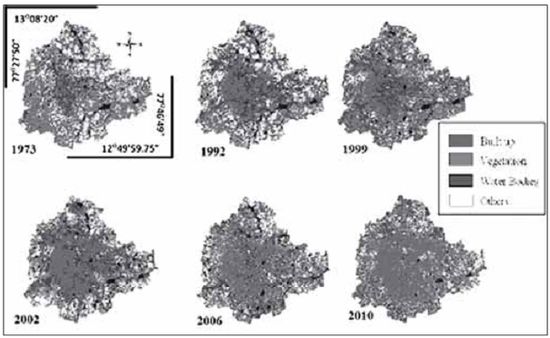
Figure 3.1: Greater Bangalore in 1973, 1992, 1999, 2002, 2006 and 2010
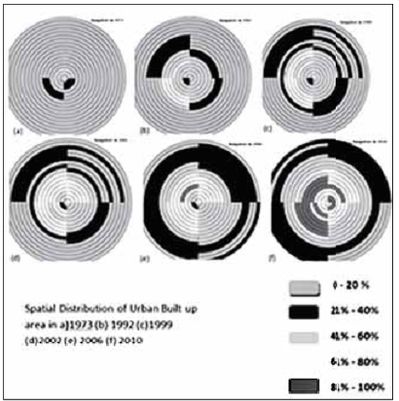
Figure 3.2: Gradient analysis of Greater Bangalore
Builtup density circlewise & zonewise from 1973 to 2010
Table 2: Greater Bangalore LC statistics

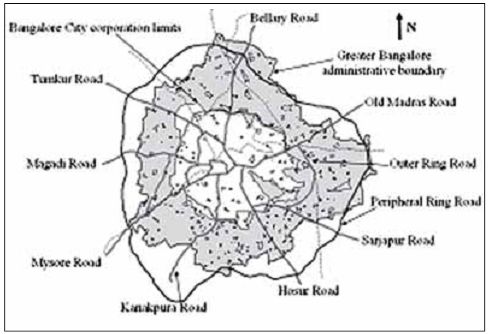
Figure 4: Greater Bangalore with 265 water bodies
LST were computed from Landsat TM and ETM thermal bands. The minimum and maximum
temperature from Landsat TM data of 1992 was 12 and 21 with a mean of 16.5±2.5 while for
ETM+ data was 13.49 and 26.32 with a mean of 21.75±2.3. MODIS Land Surface Temperature/
Emissivity (LST/E) data with 1 km spatial resolution with a data type of 16-bit unsigned
integer were multiplied by a scale factor of 0.02 (http://lpdaac.usgs.gov/modis/dataproducts.
asp#mod11). The corresponding temperatures for all data were converted to degree Celsius.
Figure 5 shows the LST map and NDVI of Greater Bangalore in 1992, 2000 and 2007. The
minimum (min) and maximum (max) temperatures were computed as 20.23, 28.29 and 23.79,
34.29 with a mean of 23.71±1.26, 28.86± 1.60 for 2000 and 2007 respectively. Data were
calibrated with in-situ measurements. NDVI was computed to study its relationship with LST.
The Landsat TM NDVI had a mean of 0.04±0.4543, ETM+ data had a mean of 0.0252±0.5369
and MODIS had a mean of -0.0917±0.5131.
The correlation between NDVI and temperature of 1992 TM data was 0.88, 0.72 for MODIS
2000 and 0.65 for MODIS 2007 data respectively, suggesting that the extent of LC with
vegetation plays a significant role in the regional LST. Respective NDVI and LST for different
land uses is given in table 3 and further analysis was carried out to understand the role of
respective land uses in the regional LST’s.
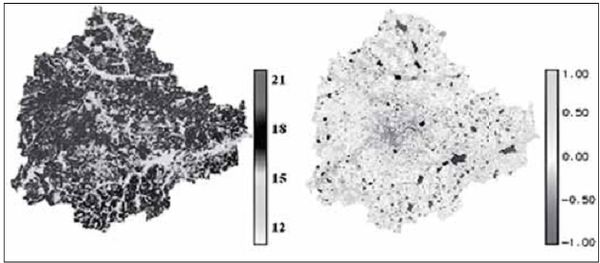
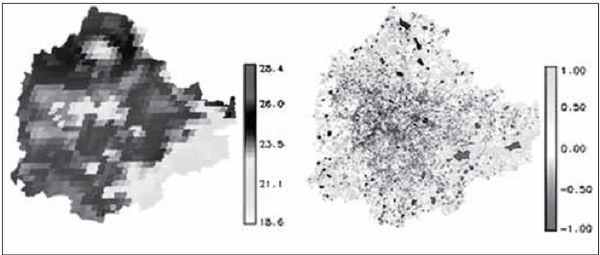
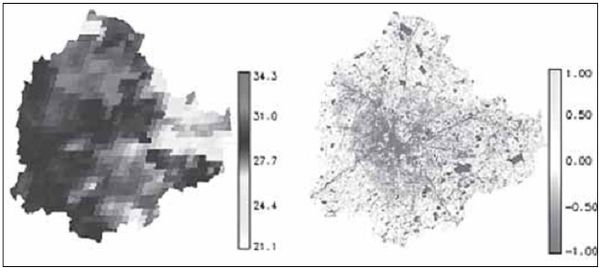
Figure 5: LST and NDVI from Landsat TM (1992), MODIS (2002 and 2007)
(Note: pixelisation of MODIS 2002 and 2007 is mainly due to coarse spatial resolution ~ 1 Km)
Table 3: LST (°C) and NDVI for various land uses

It is clear that urban areas that include commercial, industrial and residential land exhibited the
highest temperature followed by open ground. The lowest temperature was observed in water
bodies across all years and vegetation. Spatial variation of NDVI is not only subject to the
influence of vegetation amount, but also to topography, slope, solar radiation availability, and
other factors (Walsh et al., 1997). The relationship between LST and NDVI was investigated
for each LC type through the Pearson’s correlation coefficient at a pixel level and are listed
in table 4. The significance of each correlation coefficient was determined using a one-tail
Student’s t-test. It is apparent that values tend to negatively correlate with NDVI for all LC types. NDVI values for built up ranges from -0.05 to -0.6. Temporal increase in temperature
with the increase in the number of urban pixels during 1992 to 2009 (113%) is confirmed
with the increase in ‘r’ values for the respective years. The NDVI for vegetation ranges from
0.15 to 0.6. Temporal analyses of the vegetation show a decline of 65%, with a consequent
increase in the temperature.
Table 4: Correlation coefficients between LST and NDVI by LC type (p=0.05)

A closer look at the values of NDVI by LULC category (table 3) indicates that the relationship
between LST and NDVI may not be linear. Clearly, it is necessary to further examine the
existing LST and vegetation abundance relationship using fraction as an indicator. The
abundance images using linear unmixing from ETM+ bands were further analysed to
see their contribution to the UHI by separating the pixels that contains 0-20%, 20-40%,
40-60%, 60-80% and 80-100% of urban pixels. Table 5 gives the average LST for various
land use classes.
Table 5: Mean LST for various land use classes for different abundances

8 transacts were laid across the city in different directions (north [N], north-east [NE], east
[E], south-east [SE], south [S], south-west [SW], west [W] and north-west [NW]) and LST
was analysed as shown in figure 6, to understand the temperature dynamics.
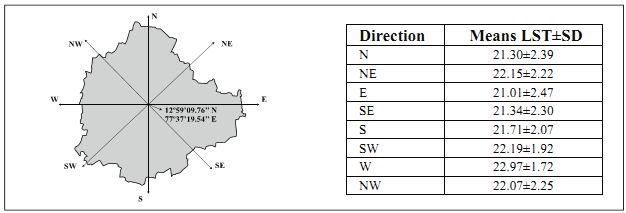
Figure 6: Transect lines superimposed on Greater Bangalore boundary
along with LST in various directions
The temperature profile was analysed by overlaying the LST map on the Baye’s classified map
to visualise the effect of vegetation, builtup, water bodies and open ground. The temperature
profile plot fell below the mean when a vegetation patch or water body was encountered on
the transact beginning from the center of the city and moving outwards along the transact. The
corresponding graphs are shown in figure 7. The major natural green area and water bodies
responsible for temperature decline are marked with circle. The spatial location of these green
areas and water bodies are shown in figure 8.


Figure 7: Temperature profile in various directions. X axis – Movement along the
transacts from the city centre, Y axis - Temperature (°C).
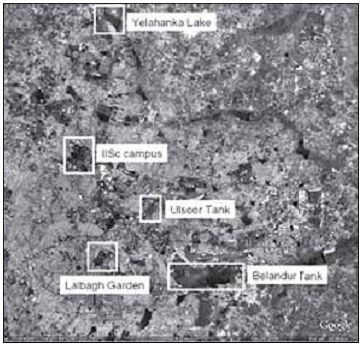
Figure 8: Google Earth image showing the low temperature areas (refer figure 7).
[Source: http://earth.google.com/]
|















